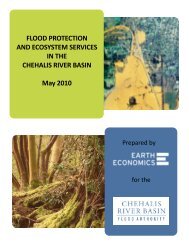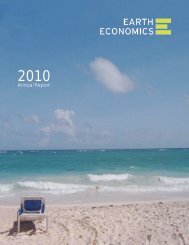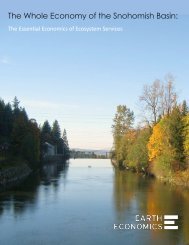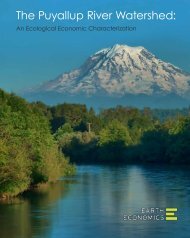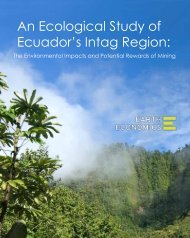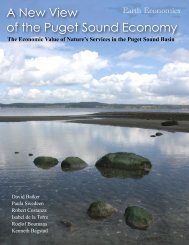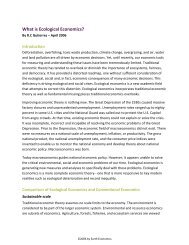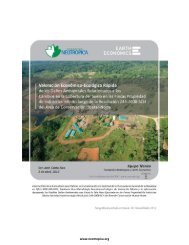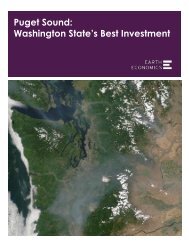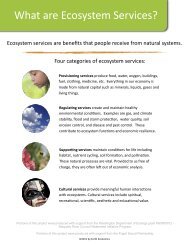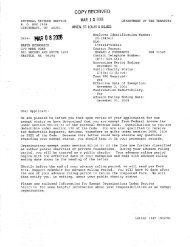The Spot Prawn Fishery: A Status Report - Earth Economics
The Spot Prawn Fishery: A Status Report - Earth Economics
The Spot Prawn Fishery: A Status Report - Earth Economics
You also want an ePaper? Increase the reach of your titles
YUMPU automatically turns print PDFs into web optimized ePapers that Google loves.
<strong>The</strong> <strong>Spot</strong> <strong>Prawn</strong> <strong>Fishery</strong>: A <strong>Status</strong> <strong>Report</strong><br />
are prey for bottom-dwelling fish and octopus.<br />
Mid-water fish species such as salmon are not<br />
known to prey on spot prawns.<br />
<strong>The</strong> abundance of predator species may have an<br />
effect on the abundance of spot prawns and other<br />
shrimp species. A study in the Barents Sea demonstrated<br />
a significant negative correlation between<br />
the abundances of cod and northern pink shrimp<br />
(Berenboim et al. 1996). Several other studies provide<br />
evidence that where fishing pressure has<br />
reduced predator populations, prey populations<br />
have increased (Witman and Sebens 1992; Aronson<br />
1989). Conversely, it is possible that the<br />
removal of shrimp by a commercial fishery plays<br />
a role in reducing the population of predator<br />
species (Fisheries and Oceans 2000b).<br />
Factors Affecting <strong>Spot</strong> <strong>Prawn</strong> Success<br />
<strong>Spot</strong> prawn reproductive and recruitment success<br />
is dependent on and likely to be affected by a broad<br />
range of environmental variables, ecological factors,<br />
and changes in ambient conditions. It is important<br />
to consider environmental parameters in the development<br />
of management systems. <strong>The</strong> following elements<br />
are likely to affect the “success” of spot prawn<br />
reproduction and recruitment (ADFG 1985):<br />
•variation in preferred water temperatures, pH<br />
levels, dissolved oxygen concentrations, and/or<br />
the general chemical composition of the water<br />
•modification of critical benthic habitat<br />
•alterations of intertidal areas<br />
•increases of suspended organic or mineral<br />
material<br />
•reduced food supply<br />
•reduced protective cover; e.g., seaweed beds<br />
•obstruction of migratory pathways<br />
•level of harvest<br />
AN OVERVIEW OF<br />
SPOT PRAWN MANAGEMENT<br />
<strong>The</strong> spot prawn fishery spans an enormous and<br />
diverse stretch of ecosystems and management<br />
jurisdictions. While there are inherent similarities<br />
in both the ecological and management systems<br />
throughout the animal’s range, there are numerous<br />
differences. <strong>The</strong>se similarities and distinctions<br />
are enumerated and discussed in detail in the later<br />
sections of the <strong>Report</strong>. <strong>The</strong> table on p.7 is an effort<br />
to summarize the nature of the fishery and its<br />
management in each of the five jurisdictions, and<br />
to set the stage for the more detailed discussions<br />
that follow.<br />
ALASKA SPOT PRAWN FISHERY<br />
Biological <strong>Status</strong> of <strong>Spot</strong> <strong>Prawn</strong>s<br />
Southeastern Alaska historically has been<br />
described as the “shrimp treasure house” (Brian<br />
Paust, University of Alaska Marine Advisory<br />
Program. Pers. comm., June 2001). While other<br />
regions—such as Prince William Sound, Kachemak<br />
Bay, and the waters off the coast of Kodiak Island—<br />
once supported spot prawn populations large<br />
enough to sustain a commercial harvest, this is no<br />
longer the case. Southeastern Alaska is now the<br />
locus of spot prawn commercial activity. (Please<br />
note: For the purposes of the <strong>Status</strong> <strong>Report</strong>, the<br />
“Alaska” section will focus primarily on the southeastern<br />
Alaska spot prawn fishery.)<br />
<strong>Spot</strong> prawns remain “cryptic” organisms whose<br />
long-term sustainability and appropriate harvest<br />
are challenged by this lack of basic biological<br />
information (Paust, University of Alaska Marine<br />
Advisory Program. Pers. comm., June 2001). At<br />
this stage, data suggest that many different areas<br />
and subpopulations of a greater metapopulation<br />
exist in the region (Love, ADFG. Pers. comm., February<br />
2001). A stated goal of management is to further<br />
this biological understanding of spot prawn<br />
abundance and distribution.<br />
Analysis of preliminary research suggests that spot<br />
prawns in southeastern Alaska may be vulnerable<br />
to serial depletion. However, results are still under<br />
review, and the data are inconclusive. Whether serial<br />
depletion is due to changing environmental conditions<br />
or the effects of fishing is not currently known<br />
(see Piatt and Anderson 1996 in Orensanz et al. 1998).<br />
In the 1960s and ’70s, the Alaska Department<br />
of Fish and Game (ADFG) collected limited catchdistribution<br />
and pot-efficiency data. A 1996 review<br />
of catch-per-unit-effort (CPUE) data available<br />
through fish tickets led to a recognition that the<br />
amount and type of biological data available were<br />
inadequate for effective spot prawn management.<br />
A stock assessment protocol to gather more information<br />
was developed, and a multi-year pilot study<br />
to obtain CPUE, size and weight, and size and sex<br />
data was begun in <strong>Fishery</strong> Management Districts 3<br />
and 7 prior to the 1996–97 fishery. <strong>The</strong> goal of this<br />
study was to: “collect and evaluate data required for<br />
rational management, to understand the variability<br />
of various parameters associated with stock assessment,<br />
to investigate factors essential to establishing<br />
an appropriate stock assessment program, and to<br />
provide information necessary to develop a well<br />
6



